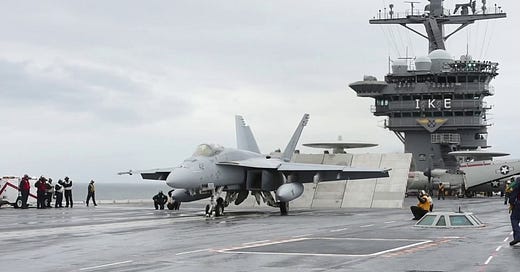As the Middle East braces itself amid the crescendo of conflict between Israel and Iran, the Biden Administration's recent military moves have added fuel to the proverbial fire. The saga commenced with a formidable display of aerial might, as the U.S. Air Force deployed an array of fighter aircraft squadrons, comprising F-35, F-15, F-16, and A-10 fighter jets, all aimed at deterring Iranian aggression.
However, the administration didn't stop at the skies. The flow of munitions to Israel witnessed a significant uptick as the U.S. expedited supplies of air defenses and munitions, thereby bolstering Israel's military capabilities against the backdrop of ongoing conflict.
The waves of the Eastern Mediterranean soon bore witness to a tangible shift in U.S. military strategy. The USS Gerald R. Ford Carrier Strike Group made its presence known in these waters, a move aimed at deterring other nations or groups from joining the war between Hamas and Israel.
And then came the announcement that added a new dimension to the unfolding scenario—the deployment of a second Aircraft Carrier, the Dwight D. Eisenhower, to the Eastern Mediterranean. Departing from Norfolk on October 14, 2023, this carrier strike group sailed to join the USS Ford Carrier Strike Group. This military move was not just a simple repositioning of assets; it was a strong statement by the U.S., signifying a dual-carrier approach to deter a widening war in the Middle East, especially in the wake of a severe Hamas attack.
The Dwight D. Eisenhower's deployment was publicly announced by U.S. Defense Secretary Austin Lloyd, marking a strategic shift that placed this nuclear-powered carrier group right next to the ongoing conflict between Israel and the militant organization Hamas. The combined naval presence of the USS Gerald R. Ford and the Dwight D. Eisenhower in the Eastern Mediterranean not only amplifies the U.S.'s military posture but also sends a clear signal to Iran and other potential adversaries in the region.
These orchestrated military maneuvers depict a clear trajectory of escalating U.S. engagement in the region. While on one hand, these steps are framed within a narrative of deterrence, they also significantly ramp up military support for Israel. The implications of these actions reverberate beyond the immediate region, rendering a complex global conundrum that necessitates a nuanced, diplomatic approach to ensure regional stability and avert a broader conflagration.
I firmly believe the choices made by the Biden Administration are bound to elicit a reaction from Iran. As the clock ticks, the nature of Iran's responses remains veiled in uncertainty, poised to potentially shift the currents of this escalating conflict. Only time will unravel the full extent of the reverberations these decisions may ignite on the turbulent stage of Middle Eastern geopolitics.




